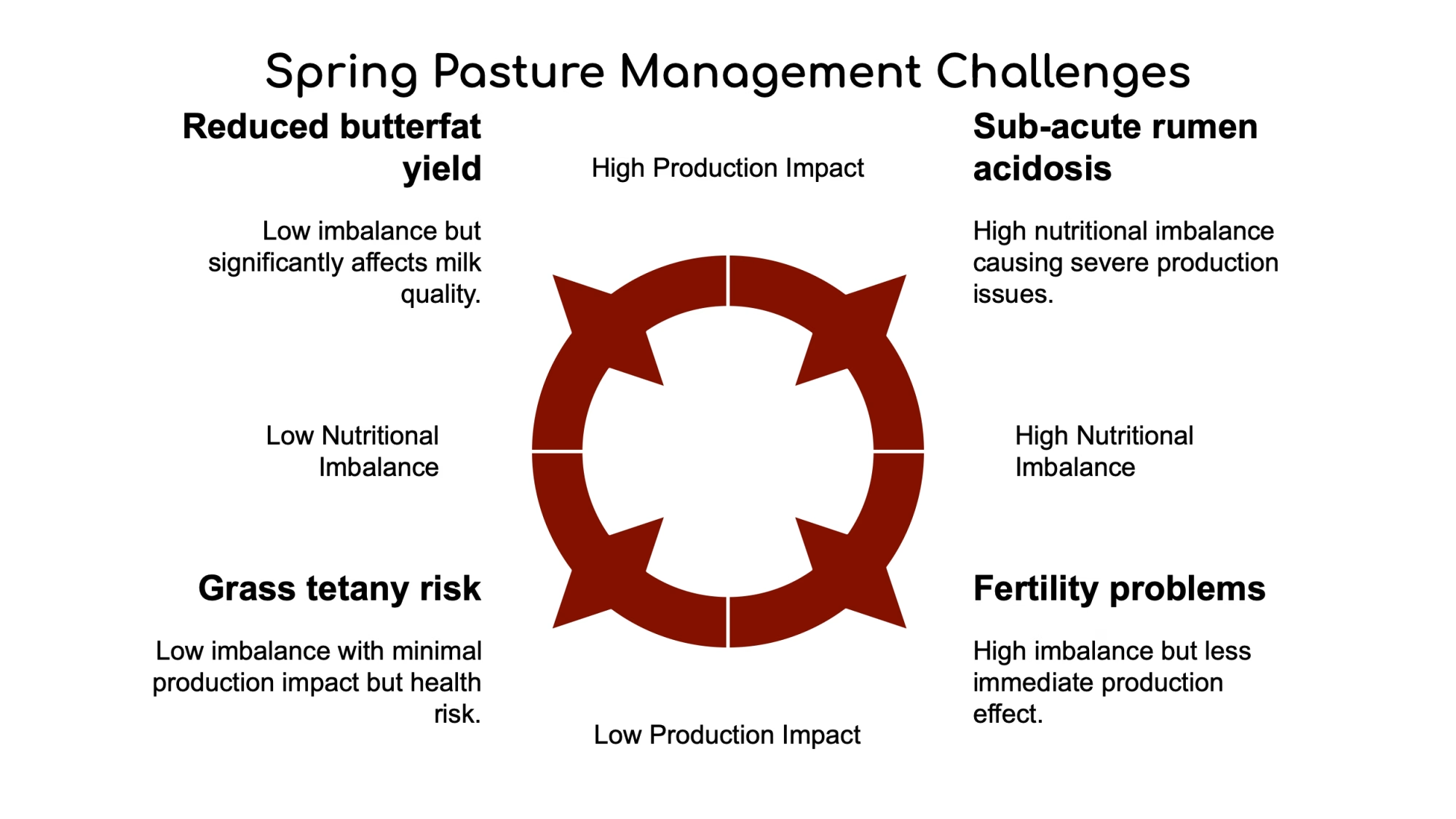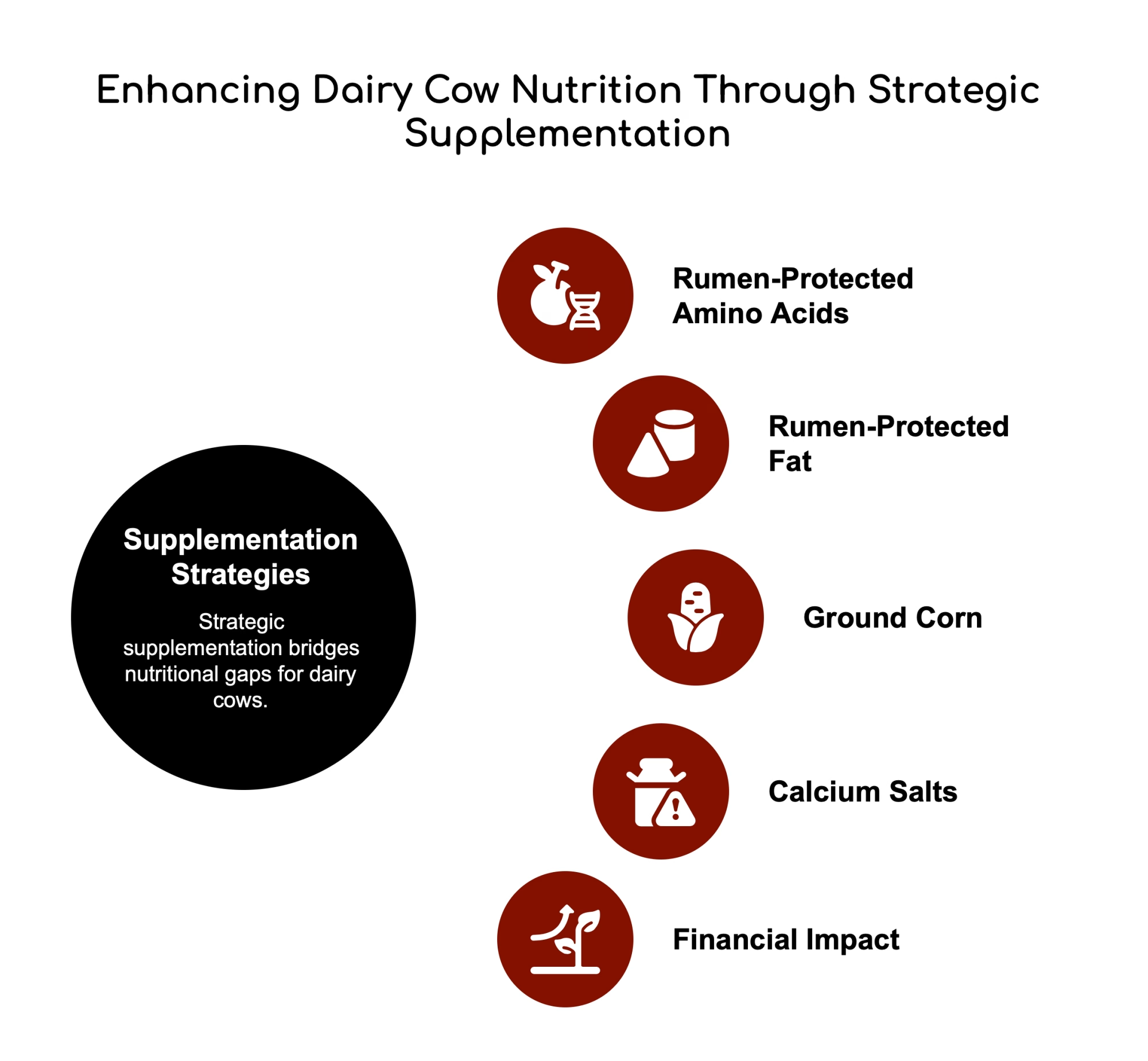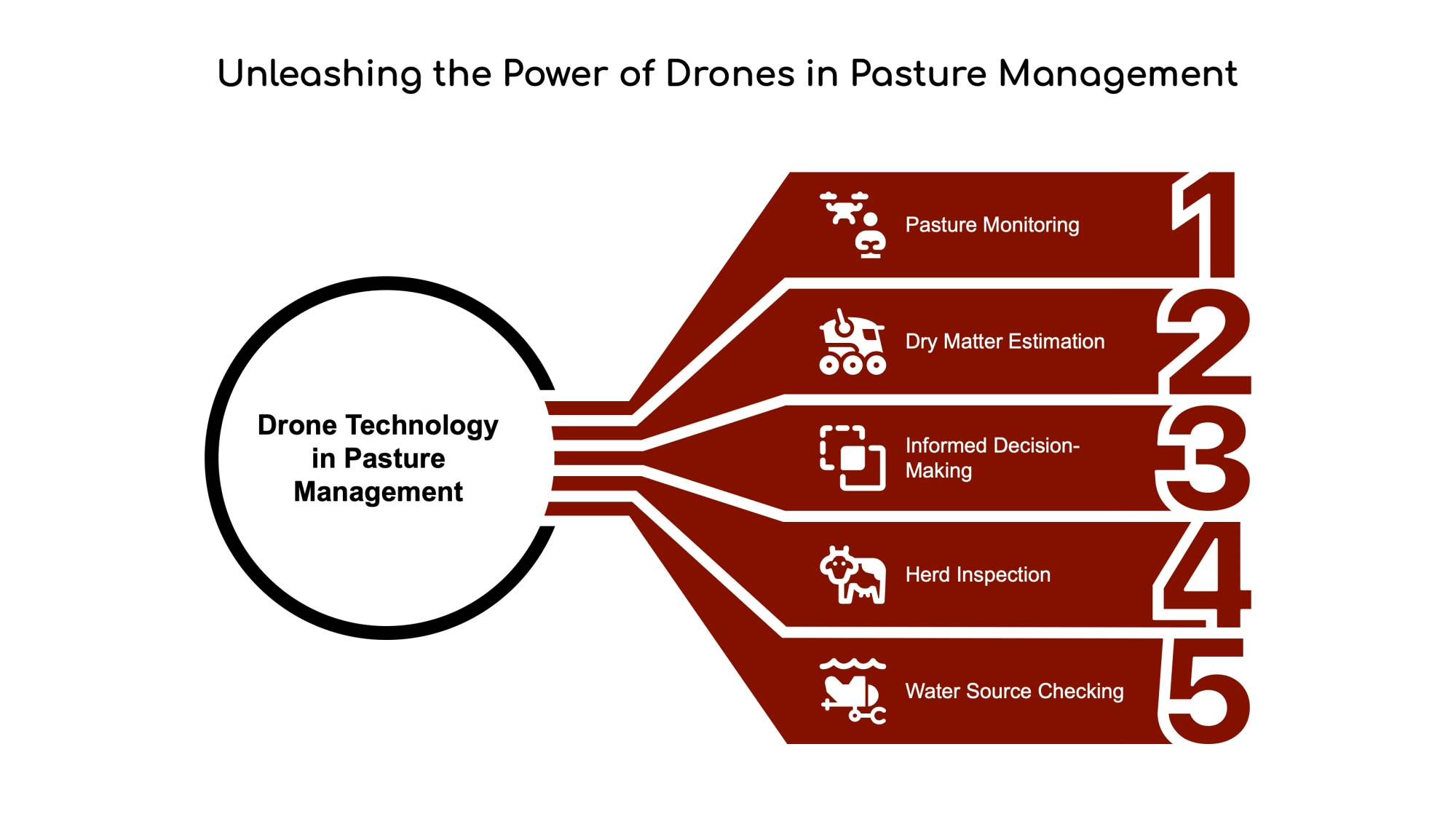Spring pastures can slash profits—discover how to protect your milk check with innovative grazing strategies.
So, we’re heading into that critical time of year again when dairy farmers across the Northern Hemisphere face one of their biggest seasonal challenges. You know what I’m talking about – that tricky transition from winter housing to spring pastures. It’s fascinating how about 63% of grazing farms are scrambling to adjust their feeding programs. And while there is tons of advice for barn-feeding systems, what about the 41% of dairy farms running grass-based operations?
The stakes are pretty high, too. I was shocked when I learned that milk component depression during this period can cost between $0.18 and $0.32 per hundredweight in quality premiums. That’s real money walking out the door during what should be your most profitable season!
Spring Pasture Pitfalls: Why Your Herd’s Profitability Is Bleeding

The spring transition typically hits in April and May, though timing varies depending on where you are and what Mother Nature decides to throw at us this year. Some lucky folks in drier regions might start early in February, while organic operations often kick off around mid-April when conditions look decent.
Young spring forage differs from winter rations; it’s a metabolic minefield! With lower structural fiber and higher sugar concentrations, this lush grass creates faster digestion rates that can wreck your cows’ rumen pH—Have you ever seen what happens when those elevated levels of unsaturated fats interfere with normal rumen biohydrogenation? It’s not pretty. These fatty acid intermediates actively block milk fat synthesis, and before you know it, your butterfat yield is down by up to 50%. It’s not just a nuisance – it’s a profit vampire sucking your milk check dry.
And don’t get me started on the moisture content! Early spring pastures often hit 75-85% moisture, limiting dry matter intake and creating nutritional chaos. This perfect storm of high moisture, high sugars, and low fiber increases the risk of sub-acute rumen acidosis – what I call “stealth rumen burnout” – that cripples production and decimates both protein and butterfat.
You might wonder – is your spring grazing plan funding your vet’s vacation home? Those lush pastures often pack elevated levels of rumen degradable protein that, when not efficiently utilized, spikes blood urea nitrogen levels. Next thing you know, you’re dealing with body condition issues, fertility problems, and hoof health nightmares. And don’t forget the mineral imbalances! Spring forages are typically potassium-rich but magnesium-poor, setting your herd up for grass tetany risks.
5 Proven Grazing Strategies That Work

Successfully balancing grazing efficiency with milk component goals starts with a gradual transition. Give your cows 2-3 weeks to adapt – think of it as retooling a factory. Skip this step, and your cows’ gut microbes go on strike! Start with just a few hours of daily grazing while offering dry hay. This provides adequate fiber to keep those rumen bugs happy until they adjust to the new menu.
Implementing rotational grazing isn’t just a good idea – it’s a game-changer. I’ve seen farms divide pastures into smaller paddocks and move cows every 12-24 hours with excellent results. This approach increases grass utilization by about 20% compared to continuous grazing. That’s a free feed! For early spring, graze cool-season pastures relatively closely, leaving about 2 inches of stubble to encourage tillering. Those side shoots will significantly boost your forage availability later in the season.
Do This Now: Walk your pastures tomorrow—if residuals are below 4 cm, slam the brakes on grazing and buffer-feed STAT.
Table: Optimal Grazing Heights for Pasture Health
| Forage Type | Begin Grazing Height | Post-Grazing Residual | Key Benefit |
| Perennial Ryegrass | 8-10 cm (3-4″) | 4-5 cm (1.5-2″) | Maintains tillering & regrowth |
| Tall Fescue | 15-20 cm (6-8″) | 5-7 cm (2-3″) | Prevents stem dominance |
| Legume Mixes | 15-25 cm (6-10″) | 7-10 cm (3-4″) | Protects crown for regrowth |
You’ll also want to maintain appropriate pre-grazing covers, especially during that second grazing round. Research shows a minimum threshold of 1600kg of dry matter per hectare ensures your cows have access to nutrient-rich sward that supports high dry matter intake. And whatever you do, don’t over-fertilize young grass in spring – you’ll just make the milk fat depression risk worse by creating even lower-fiber, faster-digesting forage.
Myth: Taller grass = better nutrition. Reality: Lush grass over 6 inches tall is a sugar bomb—it’ll crater your rumen pH faster than a Netflix binge.
Unlock Hidden Profits with Regenerative Grazing Approaches

Regenerative grazing isn’t some hippie trend – it’s a profit multiplier! I like to think of soil as your retirement account: diverse roots equal compound interest for your forage. The core principles focus on building soil health and enhancing ecosystem resilience, ultimately improving forage quality and quantity.
I’ve seen excellent results when farms implement rotational grazing with extended rest periods, allowing for complete plant regeneration and more profound root development. Plant diversity within pastures is crucial – different species have varying root depths and nutrient uptake abilities, creating more balanced nutrient cycling in the soil. These diverse root structures improve soil structure and porosity, enhancing water infiltration when needed most in spring.
A buddy of mine in Wisconsin told me, “Rotational grazing cut my feed costs by 30%—it’s like printing money in your paddocks.” And he’s not exaggerating!
Table: Regenerative Grazing Impact on Milk Components
| Practice | Milk Fat Change | Milk Protein Change | Feed Cost Reduction | Study Duration |
| 10-12 Day Rotations | +0.22% | +0.12% | 18-22% | 2-Year Trial |
| Diverse Species Mix | +0.35% | +0.18% | 25-30% | 3-Year Study |
| Strategic Rest Periods | +0.15% | +0.10% | 15-20% | 5-Year Analysis |
Regenerative practices positively influence dry matter intake through several mechanisms. Grazing forages at their mid-stage maturity offers the optimal balance of protein, energy, and mineralization to support milk fat synthesis. The improved health and nutrient density of forage from regenerative systems enhances palatability, so cows simply eat more voluntarily.
The research I’ve seen suggests that milk from cows grazing on diverse, regeneratively managed pastures contains higher concentrations of beneficial fatty acids and antioxidants. At Winrock International, studies show that implementing regenerative grazing can boost milk production per cow by 40 to 65% through improved forage digestibility. That’s not incremental improvement – that’s transformational!
4 Supplement Strategies That Rescue Milk Components Fast

Let’s be clear – supplementation isn’t just an expense; it’s an investment with measurable returns during the spring transition. Given the wild variability in spring pasture nutrition, strategic supplementation bridges those gaps and ensures a more consistent diet. Early spring grass is protein-rich but typically provides insufficient energy and fiber for high-producing cows, creating imbalances that smart supplementation can fix.
Rumen-protected amino acids (RPAAs) are my go-to targeted strategy for grazing dairy cows. Methionine and lysine are usually the first limiting amino acids in pasture-based diets. Even with adequate protein intake, deficiencies in these specific amino acids can limit milk production and component synthesis. RPAAs bypass rumen degradation and deliver these essential nutrients directly to the small intestine, with numerous studies showing improvements in milk protein synthesis, overall yield, and often enhanced milk fat content.
Table: Rumen-Protected Fat ROI Analysis (2025 Data)
| Supplement Type | Milk Yield Increase | Fat % Increase | ROI at 35ppl | Break-Even Period |
| High-C16 (Mega-Fat 88) | 1.8 L/day | +0.25% | 49% | 63 Days |
| Calcium Salts (Megalac) | 2.1 L/day | +0.35% | 83% | 42 Days |
| Ground Corn | 1.2 L/day | -0.10% | 28% | 85 Days |
Field observations from European dairy farms show that implementing feeding strategies to minimize milk fat depression can increase milk fat content by 0.14 to 0.40 percentage points. That translates to additional income between 0.28 and 1.07 € per cow daily. For a 100-cow herd over a two-month spring transition period, we’re talking about additional profit ranging from 1664 € to over 6000 €. This isn’t pocket change—serious money left in the field!
Balancing energy and protein intake is critical when supplementing grazing dairy cows during spring. With early spring grass containing high protein but low structural fiber, you need adequate energy supplementation to optimize rumen fermentation. Interestingly, simple energy supplements like ground corn can sometimes be more economically efficient than fancy high-protein commercial concentrates, mainly when your pasture already provides plenty of protein.
Revolutionary Drone Technology That Transforms Pasture Management

Pasture monitoring drones aren’t just fancy toys—they’re profit-maximizing tools that transform guesswork into precision management. I was skeptical initially, but now I’m a convert after seeing them in action! Drones with various sensors provide high-throughput imagery that estimates canopy cover across your entire grazing area. This aerial perspective lets you determine forage utilization patterns that would take hours to assess on foot.
One of the most remarkable applications is getting real-time estimates of pasture dry matter. Drones with high-resolution RGB and multispectral sensors capture detailed images that specialized software converts into pasture height, density, and biomass estimates. Different analytical methods convert this imagery into dry matter estimations, including NDVI calculations and sophisticated machine learning models. The accuracy is impressive – some studies report coefficients of determination (R²) as high as 0.94!
The practical benefits extend beyond simple pasture assessment. The real-time data enables more informed decisions about when to move cattle to new paddocks or whether supplemental feeding is necessary. Drones can also help with herd inspection, locating strays, monitoring estrus signs, observing calving, and checking water sources. All tasks become more challenging when cows transition from winter housing to expansive spring pastures.
8 Spring Pasture Profit Commandments Every Dairy Farmer Must Follow

- Transition Gradually: Implement a 2-3 week adaptation period, starting with 2-3 hours of daily grazing while offering dry hay.
- Rotate Aggressively: Divide pastures into paddocks and move cows every 12-24 hours in early spring to prevent overgrazing and maintain forage quality.
- Monitor Components Daily: Track milk fat and protein percentages as your early warning system—a 0.2% drop in fat should trigger immediate intervention.
- Buffer Feed Strategically: Provide 3-5 pounds of adequate fiber (long-stem hay) before turnout to stabilize rumen pH and prevent acidosis.
- Supplement Smart: Add rumen-protected methionine at 15-20 grams per cow daily to support milk fat synthesis during the first 4-6 weeks of spring grazing.
- Measure Pasture Weekly: Use a rising plate meter or drone technology to quantify available dry matter and adjust rotation schedules accordingly.
- Diversify Pastures: Incorporate legumes and deep-rooted forbs to improve nutrient cycling, drought resistance, and overall forage quality.
- Manage Minerals: Supplement magnesium at 50-60 grams per cow daily to prevent grass tetany during the first month of spring grazing.
The Ultimate Spring Grazing Decision: Profit or Loss?

Successfully navigating the spring pasture transition is one of the biggest challenges we face as dairy farmers trying to balance grazing efficiency with milk component goals. Everything we’ve covered points to the need for a holistic approach that integrates careful grazing management, strategic nutrition, and innovative technology adoption.
The economic implications are enormous. Milk component depression costs between $0.18 and $0.32 per hundredweight in quality premiums. But flip that around – well-managed pasture-based systems can achieve economic efficiency that rivals or exceeds confinement operations through lower feed costs and optimized resource utilization.
So, here’s my question: Will you keep hemorrhaging milk solids or pivot to profit? The clock’s ticking—spring waits for no farmer.
Takeaway Toolkit: Implement These Actions Today
- Measure pasture DM daily—if it’s under 20%, supplement with 3 lbs. starch/cow
- Track milk components twice weekly—respond immediately to any downward trend
- Implement 12-hour paddock moves during the first 3 weeks of spring grazing
- Supplement magnesium oxide at 2 oz/cow/day during the first month on pasture
- Maintain post-grazing residual of 4-6 cm to optimize regrowth quality
- Consider drone technology for more precise pasture management decisions
Executive Summary
Spring pasture transition poses significant challenges for dairy farmers, with milk component depression risking $0.18–$0.32/cwt in lost premiums. Rapidly growing, nutrient-imbalanced grass disrupts rumen health, slashing up to 50% of butterfat yields. Success hinges on gradual herd adaptation (2–3 weeks), rotational grazing to boost forage use by 20%, and strategic supplements like rumen-protected amino acids to rescue milk components. Regenerative practices enhance soil health and milk quality, while drones provide real-time pasture data for precision decisions. Farmers can turn spring’s risks into profitable opportunities by balancing these strategies.
Key Takeaways
- Gradual transition (2–3 weeks) prevents rumen shock and maintains milk fat/protein levels
- Rotational grazing boosts pasture yield by 20% and extends grazing seasons through strategic paddock management
- Targeted supplements (e.g., methionine/lysine) increase milk fat by 0.14–0.40%—adding €1,664–6,000/100 cows over 2 months
- Regenerative grazing diversifies pastures, cuts feed costs by 15–30%, and improves milk’s nutritional profile
- Drone tech delivers 94% accurate biomass data, enabling smarter grazing rotations and healthier herds
Learn more:
- Top 5 Proven Tips to Prevent Milk Quality Decline at Turnout
Provides practical strategies for maintaining milk quality during the critical transition to spring pastures. - Maximizing Milk Solids Output Through Strategic Nutrition and Genetics
Explores how effective grazing management and genetic selection can optimize milk component production. - Regenerative Dairy Farming: Sustaining the Land and the Herd
Examines how regenerative practices like rotational grazing can improve soil health, animal welfare, and dairy product quality.
 Join the Revolution!
Join the Revolution!
Join over 30,000 successful dairy professionals who rely on Bullvine Daily for their competitive edge. Delivered directly to your inbox each week, our exclusive industry insights help you make smarter decisions while saving precious hours every week. Never miss critical updates on milk production trends, breakthrough technologies, and profit-boosting strategies that top producers are already implementing. Subscribe now to transform your dairy operation’s efficiency and profitability—your future success is just one click away.







 Join the Revolution!
Join the Revolution!





